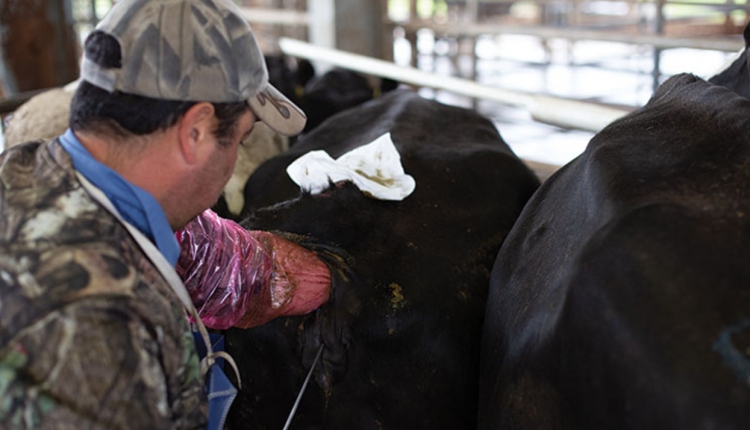The author is a reproductive specialist at ABS Global.
Reproduction drives the dairy farm business. Not only does it determine peak milk production but it drives the operation's long-term replacement pipeline.

Dirt lots when well managed (dry, with soft surfaces, and free of rocks) offer an excellent area
for heat expression. Healthy cows with limited foot issues also show more heats.
With that in mind, getting cows safe in calf is a top priority. In order to ensure success, we can all become better heat detectors. But it isn't quite that simple. Here are some steps that can be taken to do a better job:
Establish a Standard Operating Procedure (SOP): It is imperative to establish, clearly communicate, and follow a SOP. This communication (preferably written and posted) needs to include:
Optimize observation time: Observe cows in places where they are most likely to show heat. It is known that most of the heat activity occurs during the night and early in the morning. This concept still applies to some dairies; however, in operations with more intensive management systems, such as three or more milkings per day, several feeding periods, and movement for herd health, heat expression can occur at any time.
Generally, estrus expression is limited during feeding and periods of high temperature and humidity. On the other hand, more heats are expressed when cows are going into or returning from milking or during pen movement. Remember, today's cows show shorter and less intense heats compared to counterparts decades ago making heat detection more challenging. The recommendation is to observe cows as many times and as frequent as possible. For example, heat should be observed at intervals of 6 to 8 hours four times per day.
Offer adequate footing surface: A comfortable flooring surface with sound traction allows cows to feel safe which promotes heat expression. Dirt lots when well managed (dry, with soft surfaces, and free of rocks) offer an excellent area for heat expression. Pens with concrete flooring usually present a more challenging environment for mounting activity. Wet and slippery concrete make cows feel unsafe and would decrease mounting activity, while rubber flooring gives cows more confident footing.
Avoid overcrowding: Cows need enough space to interact and express heat. Overcrowded pens not only limit the physical space for mounting activity but also increase the level of stress due to the constant competition for feed, water, and bedding. Under these conditions, heat activity drops drastically.
Minimize feet and leg problems: Lame cows don't mount and don't allow other cows to mount. When cows go lame, it should be common practice to treat them immediately. Also, establish a routine for monitoring of locomotion. It is critical to minimize the time that cows are standing on concrete and other factors that increase the risk of laminitis.
Use heat detection aids: These tools help identify changes in cow's behavior such as mounting activity or increased locomotion. One of the tools commonly used is chalk or paint. The minimum condition for this technique to work is to mark every eligible cow every day. This daily contact creates the opportunity for detection.
Put the pieces together: Use all the information you have available to make the best breeding decision possible. Some cows are relatively easy to detect in heat but others are questionable and require further investigation. In this case, in addition to the primary and secondary signs of heat, use the information provided by the records and the heat detection aids. If it is part of your protocol, palpate those cows for tone and mucus.
Control the variation of days in milk (DIM) at first service: It is common to find herds where a lot of cows (20 percent) are bred for the first time with more than 90 to 100 DIM. These are eligible cows that for whatever reason were not detected in heat or did not express heat. To avoid this situation, establish a goal in DIM by which at least 95 percent of eligible cows should be bred for the first time and incorporate a TAI program to comply with this goal.
Preg check early and reconfirm: The rapid identification of open cows after breeding as well as those that lose the pregnancy is a key strategy to boost submission rates if you enroll those cows back into the breeding pool.
Re-enroll or resynchronize: Most open cows should be incorporated immediately into the breeding group. With the tools available today (Ovsynch), the majority of these cows should be bred again within the following 10 days after diagnosed open.
In general, the combination of efficient practices that promote heat expression and detection with those that create opportunities for inseminating eligible cows like the use of TAI is the best strategy to increase risk insemination rates in your herd. Remember, a good A.I. breeder is not the one who detected and bred more cows but the one who bred more cows that were truly in heat.
Click here to return to the Reproduction E-Sources
100425_305
Reproduction drives the dairy farm business. Not only does it determine peak milk production but it drives the operation's long-term replacement pipeline.

for heat expression. Healthy cows with limited foot issues also show more heats.
With that in mind, getting cows safe in calf is a top priority. In order to ensure success, we can all become better heat detectors. But it isn't quite that simple. Here are some steps that can be taken to do a better job:
Establish a Standard Operating Procedure (SOP): It is imperative to establish, clearly communicate, and follow a SOP. This communication (preferably written and posted) needs to include:
- Who handles heat detection
- Where it takes place
- How long and how often
- What heat detection aids are used
- How to use those aids
- What to do once a cow is detected in heat
Optimize observation time: Observe cows in places where they are most likely to show heat. It is known that most of the heat activity occurs during the night and early in the morning. This concept still applies to some dairies; however, in operations with more intensive management systems, such as three or more milkings per day, several feeding periods, and movement for herd health, heat expression can occur at any time.
Generally, estrus expression is limited during feeding and periods of high temperature and humidity. On the other hand, more heats are expressed when cows are going into or returning from milking or during pen movement. Remember, today's cows show shorter and less intense heats compared to counterparts decades ago making heat detection more challenging. The recommendation is to observe cows as many times and as frequent as possible. For example, heat should be observed at intervals of 6 to 8 hours four times per day.
Offer adequate footing surface: A comfortable flooring surface with sound traction allows cows to feel safe which promotes heat expression. Dirt lots when well managed (dry, with soft surfaces, and free of rocks) offer an excellent area for heat expression. Pens with concrete flooring usually present a more challenging environment for mounting activity. Wet and slippery concrete make cows feel unsafe and would decrease mounting activity, while rubber flooring gives cows more confident footing.
Avoid overcrowding: Cows need enough space to interact and express heat. Overcrowded pens not only limit the physical space for mounting activity but also increase the level of stress due to the constant competition for feed, water, and bedding. Under these conditions, heat activity drops drastically.
Minimize feet and leg problems: Lame cows don't mount and don't allow other cows to mount. When cows go lame, it should be common practice to treat them immediately. Also, establish a routine for monitoring of locomotion. It is critical to minimize the time that cows are standing on concrete and other factors that increase the risk of laminitis.
Use heat detection aids: These tools help identify changes in cow's behavior such as mounting activity or increased locomotion. One of the tools commonly used is chalk or paint. The minimum condition for this technique to work is to mark every eligible cow every day. This daily contact creates the opportunity for detection.
Put the pieces together: Use all the information you have available to make the best breeding decision possible. Some cows are relatively easy to detect in heat but others are questionable and require further investigation. In this case, in addition to the primary and secondary signs of heat, use the information provided by the records and the heat detection aids. If it is part of your protocol, palpate those cows for tone and mucus.
Control the variation of days in milk (DIM) at first service: It is common to find herds where a lot of cows (20 percent) are bred for the first time with more than 90 to 100 DIM. These are eligible cows that for whatever reason were not detected in heat or did not express heat. To avoid this situation, establish a goal in DIM by which at least 95 percent of eligible cows should be bred for the first time and incorporate a TAI program to comply with this goal.
Preg check early and reconfirm: The rapid identification of open cows after breeding as well as those that lose the pregnancy is a key strategy to boost submission rates if you enroll those cows back into the breeding pool.
Re-enroll or resynchronize: Most open cows should be incorporated immediately into the breeding group. With the tools available today (Ovsynch), the majority of these cows should be bred again within the following 10 days after diagnosed open.
In general, the combination of efficient practices that promote heat expression and detection with those that create opportunities for inseminating eligible cows like the use of TAI is the best strategy to increase risk insemination rates in your herd. Remember, a good A.I. breeder is not the one who detected and bred more cows but the one who bred more cows that were truly in heat.
100425_305








